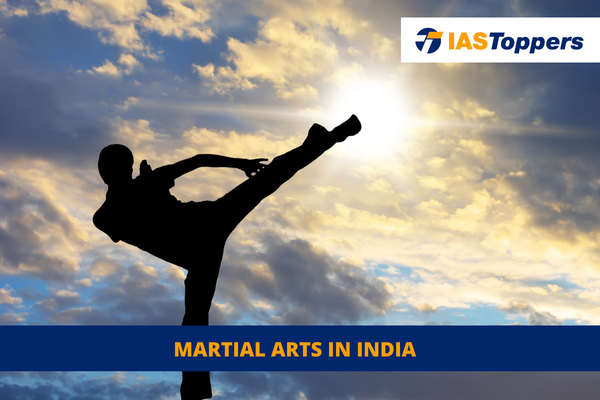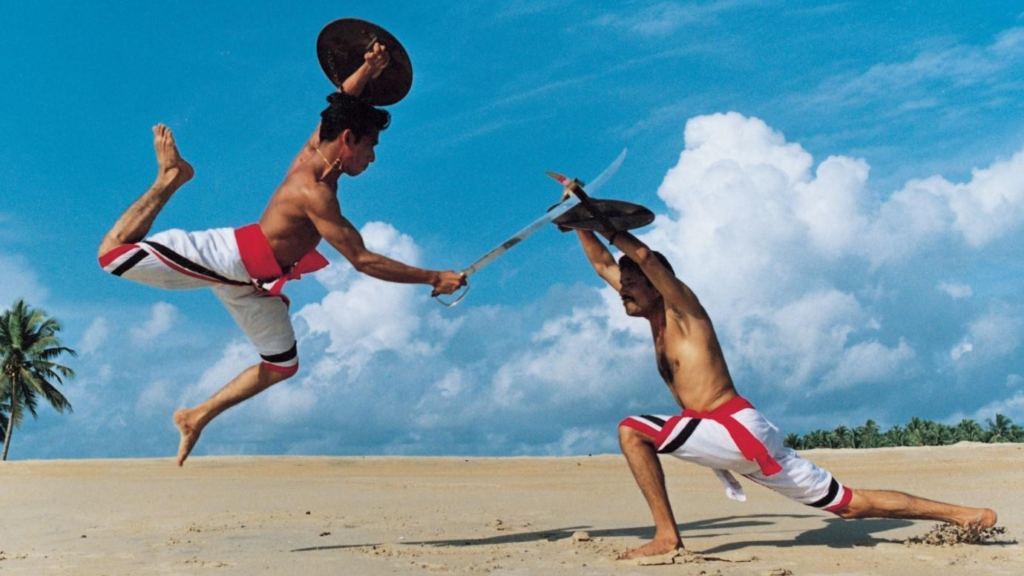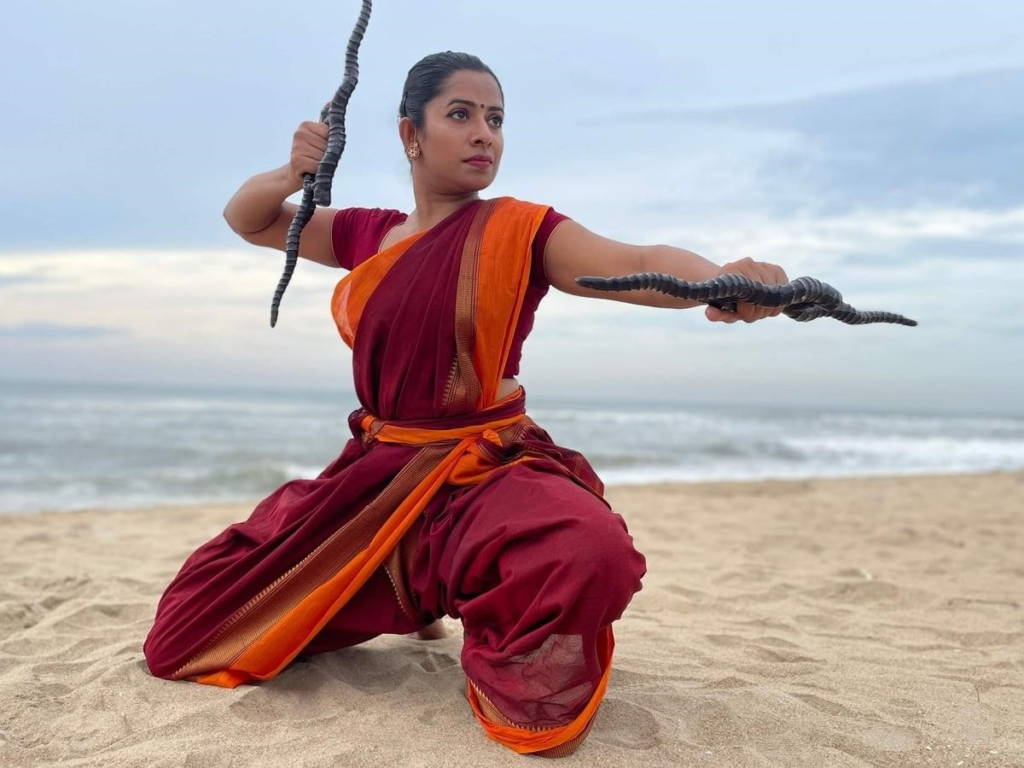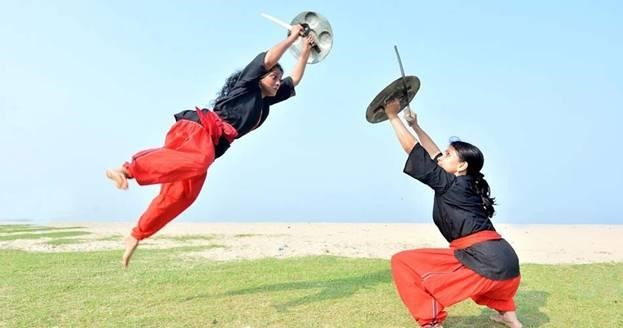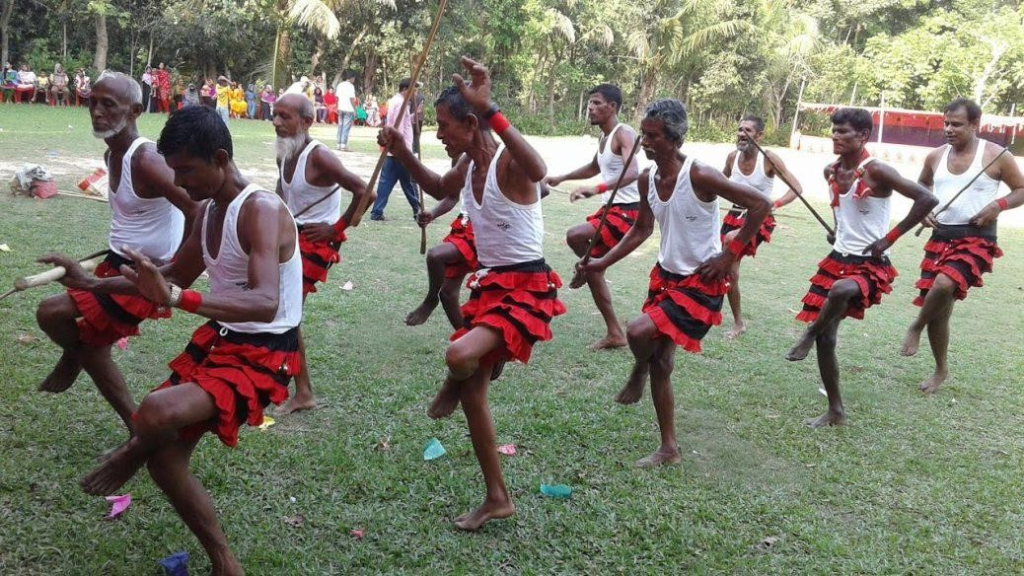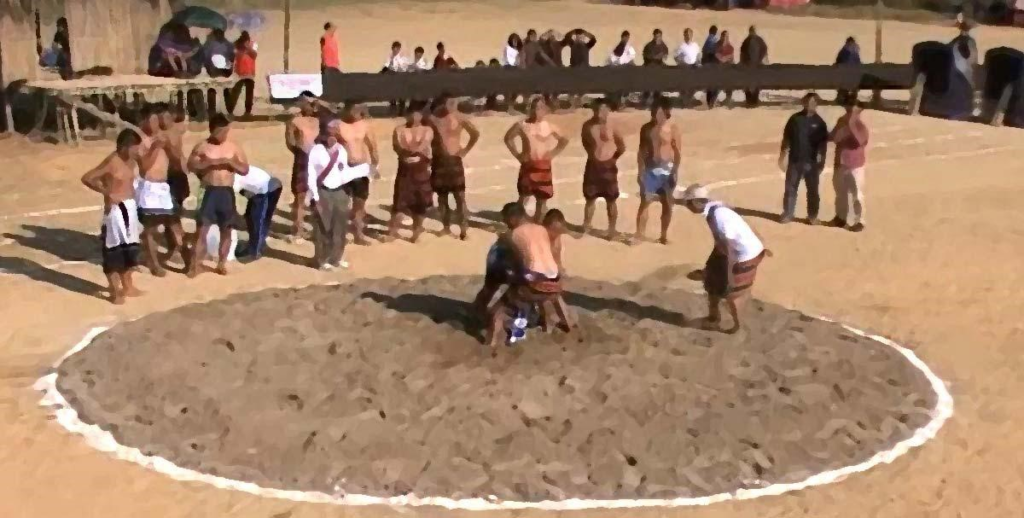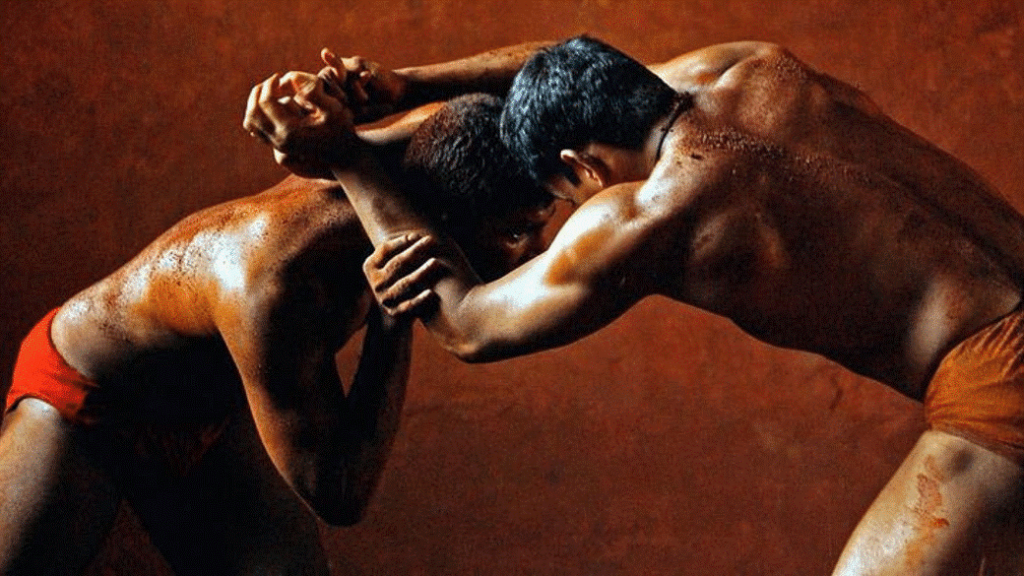Martial Arts of India are known as the fighting systems of the Indian subcontinent. Various terms, mostly rooted in Dravidian origins, are used to describe the English phrase “Indian martial arts.” One commonly used term nowadays is astra-vidy, which combines the words “weapon” (astra) and “science” (vidy) to signify knowledge in this field. Another term, Dhanurveda, is derived from “bow” (dhanushya) and “knowledge” (veda). It originally referred to the “science of archery” described in Puranic literature and later encompassed martial arts in general.
Martial Arts of India will be helpful for UPSC IAS Exam preparation. GS Paper-1 Art and Culture.
Table of Content
- Martial Arts in India
- Statewise Martial Arts in India
- Kalaripayattu
- Silambam
- Thang-ta and Sarit Sarak
- Cheibi Gad-ga
- Pari-khanda
- Thoda
- Gatka
- Mardani Khel
- Lathi
- Inbuan Wrestling
- Kuttu Varisai
- Musti Yuddha
- Some other prominent martial arts of India
- Conclusion
- Frequently Asked Questions
- Conclusion
- Frequently Asked Questions (FAQs)
Martial Arts in India
- India, a land known for its rich cultural diversity, has a wide array of martial arts that have evolved over centuries.
- Indian martial arts were originally developed for warfare, and have transformed into art forms used for various purposes in modern times.
- Today, martial arts in India are primarily practised for demonstrations, rituals, physical fitness, and self-defence.
- The term “martial art” refers to the arts associated with the act of waging war.
- Many of the martial arts forms in India share close connections with dance, yoga, and performing arts.
- During British rule, certain martial arts forms like Kalaripayattu and Silambam were banned, but they resurfaced and regained popularity after India’s independence.
Origin of Martial Arts in India
The Vedas’ Dhanurveda:
- The Vedas’ Dhanurveda section (1500 BCE – 1100 BCE) contains mentions of martial arts.
- Indian epics hold the oldest tales of battle, both armed and unarmed.
Mahabharata:
- The Mahabharata depicts a prolonged battle between Arjuna and Karna, showcasing the use of bows, swords, trees, boulders, and fists to defeat lions with daggers.
Malla-yuddha:
- Malla-yuddha, also known as combat-wrestling, is the oldest documented structured unarmed fighting technique in the Indian subcontinent.
- During the Vedic Period, it was formalized into four styles.
- Various mainstream games described in the Vedas and epics, such as boxing, chariot racing, wrestling, horseback riding, and archery, originated from military training.
Martial Arts Literature:
- Martial arts literature, like other Sanskrit literature, became increasingly methodical around the 1st century AD.
- The warrior class (Kshatriya caste) practised martial arts more frequently, but non-Kshatriya students from across the subcontinent also learned fighting tactics in educational institutions.
- The 8th-century work Kuvalaymala by Udyotanasuri provides insights into the study of martial arts.
Gurjara-Pratiharas:
- During the Caliphate wars in India, the Gurjara-Pratiharas regularly repelled Arab incursions.
- An Arab chronicler named Sulaiman praised the Gurjara monarch as the greatest obstacle to Islamic expansion and admired their cavalry.
- The Gurjara people continue to practice gatka and kushti, and their wrestlers compete at national and international levels.
Physical Culture in India:
- Invading Muslim armies occupied India for centuries until its emancipation.
- Both nobility and commoners in the empire valued physical culture, with wrestling being particularly popular among men and women.
- Gymnasiums were discovered within the royal quarters of Vijayanagara, and documents mentioned frequent physical training for commanders and their armies during peacetime.
- Royal palaces and market areas hosted unique events like cockfights, ram bouts, and wrestling matches.
Mughal Era:
- Babur, a conqueror from Central Asia, established Mughal dominion in north India during the 16th century.
- The Mughals supported native arts, enlisting Rajput combatants trained in an akhara (wrestling schools) and even performing themselves.
- The Mughal court attracted fighting men from different parts of the empire who exhibited their talents daily for rewards, according to the Ain-i-Akbari.
Top martial arts in India
The list of different types of martial arts in India is given below:
| Martial Arts | Location |
| Kalaripayattu | Southern India, Kerala |
| Silambam | Tamil Nadu |
| Thang-ta and Sarit Sarak | Manipur |
| Cheibi Gad-ga | Manipur |
| Pari-khanda | Bihar |
| Thoda | Himachal Pradesh |
| Gatka | Punjab |
| Mardani Khel | Maharashtra |
| Lathi | Punjab, Bengal |
| Inbuan Wrestling | Mizoram |
| Kuttu Varisai | Tamil Nadu |
| Musti Yuddha | Varanasi |
Kalaripayattu
- Kalaripayattu is one of the oldest martial arts in India, traces its origins back to the 3rd century BC.
- Kalaripayattu forms the part of Kerala martial arts even though being practiced in Southern India.
- The term “Kalari” in Malayalam refers to a specialized training hall or gymnasium.
- Elements: armed, unarmed combat and physical exercises.
- Unlike some other martial arts, Kalaripayattu does not involve drumming or singing; instead, the emphasis lies on the fighting style itself.
- Footwork plays a crucial role in Kalaripayattu, along with techniques such as kicks, strikes, and weapon-based training.
- Participants: both men and women participate, highlighting its inclusivity.
- The art form consists of multiple techniques and aspects, such as Uzhichil (massage using Gingli oil), Otta (combat with an ‘S-shaped stick), Maipayattu (body exercises), Puliyankam (sword fight), Verumkai (bare-handed combat), and Angathari (usage of metal weapons and Kolthari sticks).
Silambam
- Silambam is a modern and scientific martial art form from Tamil Nadu that focuses on staff fencing.
- During the reigns of the Pandyas, Cholas, and Cheras, Silambam was actively promoted and practised.
- The historical evidence of Silambam can be traced back to the Tamil literatureSilappadikaram, which dates back to the 2nd century AD.
- It mentions the trade of silambam staves, pearls, swords, and armour with foreign traders.
- Silambam bamboo staves were highly sought-after trading items by visitors and traders from Rome, Greece, and Egypt.
- This martial art form spread to Malaysia from its originating state, where it gained popularity as both a sport and a means of self-defence.
- Silambam utilizes long staff for both simulated combat and self-defence techniques.
- Techniques: foot movements, dual-handed staff manoeuvres, and the use of thrusts, cuts, chops, and sweeps to attain mastery.
- Precision, force, and momentum are developed at different levels of the body, such as the head, shoulder, hip, and leg.
- Silambam practitioners are trained to counter an unruly mob by employing specialized strikes like snake hits, monkey hits, and hawk hits.
- They are also skilled in deflecting stones thrown at them.
Thang-ta and Sarit Sarak
- Thang-ta and Sarit Sarak are ancient martial arts created by the Meitei people of Manipur.
- Thang-ta derives its name from the words “Thang” meaning “sword” and “Ta” meaning “spear,” signifying the primary weapons used in this art form.
- Thang-ta is an armed martial art that is renowned for its deadly combat techniques.
- Sarit Sarak, on the other hand, is an unarmed art form that focuses on hand-to-hand combat.
- Historical significance: These martial arts can date back to the 17th century when they were effectively employed by Manipuri kings during conflicts with the British.
- However, with the British occupation of the region, Thang-ta and Sarit Sarak were banned for some time.
- After India gained independence, there was a revival and resurgence of these martial arts.
- Together, Thang-ta and Sarit Sarak are collectively referred to as Huyen Langlon.
Cheibi Gad-ga
- Cheibi Gad-ga is a highly ancient martial art form originating from Manipur.
- This martial art involves combat using a sword and shield, but it has undergone modifications in recent times.
- Instead of a sword, a stick encased in soft leather is now used, and the traditional shield has been replaced by a leather shield.
Cheibi Gad-ga contest
- The contest takes place within a circular area with a diameter of 7 meters on a flat surface.
- Inside the circle, two lines are marked, positioned 2 meters apart from each other.
- The “Cheibi” stick used in Cheibi Gad-ga measures between 2 to 2.5 feet in length, while the shield has a diameter of approximately 1 meter.
- Victory in a Cheibi Gad-ga contest is determined by the points earned during the duel.
- Points are awarded based on a combination of skilful techniques and the display of physical strength.
Pari-khanda
- Pari-khanda is a martial art form hailing from Bihar and was created by the Rajputs.
- This art form primarily focuses on combat techniques utilizing a sword and shield.
- The steps and techniques of Pari-khanda have also been incorporated into the expressive Chhau dance.
- The name “Pari-khanda” combines two words: “Pari,” which means shield, and “khanda,” referring to a sword.
- This highlights the use of both a sword and a shield in this martial art form.
Thoda
- Thoda, a fascinating blend of martial arts, sports, and cultural traditions, originates from the state of Himachal Pradesh.
- This vibrant martial art form is prominently showcased during the Baisakhi festival, held annually in April.
- The practitioners of Thoda engage in community prayers to seek the blessings of the principal deities, Goddesses Mashoo and Durga.
- Thoda draws its essence from the ancient times of the Mahabharata, where bows and arrows were utilized in the epic battles that took place in the picturesque Valleys of Kullu and Manali.
Thoda Game
- During the game, two groups, consisting of approximately 500 participants each, participate.
- While not all of them are archers, many are skilled dancers who contribute to boosting their respective team’s morale.
- To maintain discipline, Thoda is played in a designated court that is marked for precise gameplay.
- The two teams involved in Thoda are known as Pashis and Saathis, believed to be the descendants of the legendary characters, the Pandavas and Kauravas from the Mahabharata.
- In Thoda, the archers aim for the leg, specifically below the knee, as striking any other part of the body results in negative points.
Gatka
- Gatka is a traditional martial art of India practiced by Sikhs in Punjab.
- Gatka is a weapon–based martial art that involves sticks, Kirpans (ceremonial swords), Talwars (swords), and Kataars (dagger-like weapons).
- Gatka martial artsinvolves thetechniquesof Attack and defense depending on hand and foot positions and the chosen weapon.
- Gatka art is showcased during various festivities and fairs in the region.
Mardani Khel
- Mardani Khel is a traditional martial art from Maharashtra, particularly in Kolhapur district.
- Mardani Khel focuses on armed combat with swift movements, low stances, and proficiency with swords.
- Weapons used in Mardani Khel: Patta (sword) and Vita (corded lance).
- Prominent artist of Mardani Khel: Chhatrapati Shivaji Maharaj.
Lathi
- Lathi is an ancient martial art form of India.
- Lathi revolves around the use of a long stick or cane or lathi, typically 6 to 8 feet in length.
- Lathi is one of the world’s oldestweapons used in martial arts.
- Lathi is often tipped with metal.
- Lathi is frequently employed by the Indian police for crowd control.
- Lathi is widely practiced in Punjab and Bengal.
- Lathi is one of the popular sports in villages.
Inbuan Wrestling
- Inbuan Wrestling is a native martial art from Mizoram.
- Inbuan Wrestling traces its origins back to 1750 AD.
- Inbuan Wrestling follows strict rules that prohibit stepping out of the circle, kicking, and bending knees.
- Victory is achieved in Inbuan Wrestling by lifting the opponent off their feet while adhering to the rules.
- Wrestlers in Inbuan Wrestling also engages in catching the belt worn around the waist of the other wrestlers during the match.
Kuttu Varisai
- Kuttu Varisai is also known as Empty-Hand combat.
- Kuttu Varisai was first mentioned in Sangam literature (1st or 2nd century BC).
- Kuttu Varisai is an unarmedDravidian martial art practiced majorly in Tamil Nadu.
- It gained popularity in parts of Sri Lanka and Malaysia.
- Kuttu Varisai combines stretching, yoga, gymnastics, and breathing exercises to enhance athleticism and footwork.
- Kuttu Varisai incorporates grappling, striking, and locking techniques with animal-inspired movements like those of snakes, eagles, tigers, elephants, and monkeys.
- Kuttu Varisai is considered the unarmed aspect of Silambam.
Musti Yuddha
- Musti Yuddha had originated from the ancient city of Varanasi.
- Musti Yuddha is an unarmed martial art that resembles boxing.
- Musti Yuddha incorporates kicks, punches, knee strikes, and elbow strikes.
- Musti Yuddha was most popular during the 1960s.
- Musti Yuddha emphasizes the development of physical, mental, and spiritual aspects.
- Fights in Musti Yuddha are categorized into four and named after Hindu deities associated with specific techniques.
- CategoriesofMusti Yuddha:
- Jambuvanti: emphasises submission through locking and holding
- Hanumanti: focuses on technical superiority
- Bhimaseni: highlights sheer strength
- Jarasandhi: concentrates on limb and joint manipulation.
Some other prominent martial arts of India
| Martial Art | Place of Origin | Description |
| Paika Akhada | Odisha | Combination of dance and combat. Earlier used by warriors, now practiced as a performing art. |
| Sqay | Kashmir | Use of swords and shields |
| Kathi Samu | Andhra Pradesh | Ancient skill mastered by royal armies of the State. |
| Bandesh | India | An ancient unarmed art. Ituses various lock holds against an armed opponent without killing them. |
| Malla Yuddha | South India | Traditional combat wrestling related to other Southeast Asian wrestling styles including Naban. Prominent artist: Siddhartha Gautama, Krishna Deva Raya, etc. |
| Malla Khamb | 12th century in Maharashtra | Uses pole and rope. It requires great concentration. |
| Insu Knawr | Mizoram | Players use round wooden rod to play this game within a circle. |
| Kirip, Saldu | Nicobar | Also known as Nicobarese wrestling |
| Varma Ati | Tamil Nadu | Attacks are aimed at body’s vital spots |
Conclusion
From the weapon-based forms like Gatka and Mardani Khel to the unarmed arts like Kuttu Varisai and Musti Yuddha, each martial art of India carries its unique traditions, techniques, and cultural significance. These disciplines not only promote physical prowess but also foster mental and spiritual growth. Martial arts continue to captivate and inspire individuals and preserves ancient traditions.
The traditional Martial Arts of India demonstrates India’s rituals, physical fitness, and self-defence. These practices exemplify the profound interconnections between martial arts, dance, yoga, and performing arts. Exploring the origins and diverse forms of martial arts in India sheds light on the cultural and historical significance of these age-old traditions. There are many benefits of martial arts as it teaches self-control and enhances discipline amongst the performer. The most popular martial arts in India have been used as a Soft Power diplomacy by Indian government in various countries.
Ref:Source-1
| Other Articles in History & Culture | |
| Dravida Temple Style (South Indian temple style) | Industrial Revolution |
| Tribes in India | Classical Sanskrit Theatre |
| Left-Wing Movement in India | Ellora Caves |
FAQs (Frequently Asked Questions)
What is martial arts?
Martial arts are structured systems and traditions of combat practiced for many reasons such as self-defense, military, competition, physical and mental development and to preserve a nation’s intangible cultural heritage.
Give some examples of Traditional Martial Art forms in India.
Kalaripayattu, Silambam, Thang-ta and Sarit Sarak, Thoda, Gatka etc are some of the famous martial arts in India.
In which state Gatka is practised?
Gatka is practised in Punjab.
In which state Mardani Khel is practised?
Mardani Khel is practised in Maharashtra.
In which state Inbuan Wrestling is practised?
Inbuan Wrestling is practised in Mizoram.


